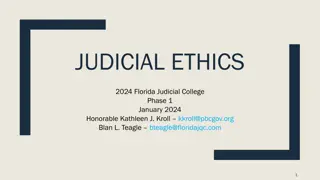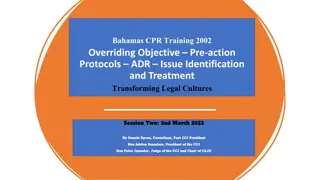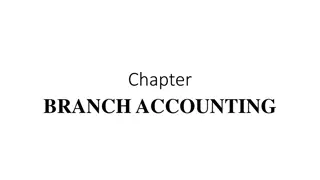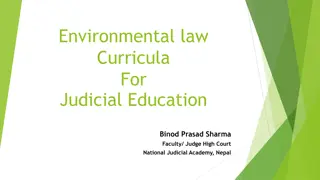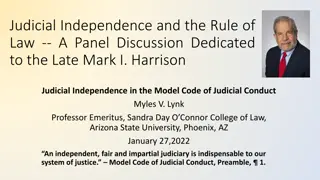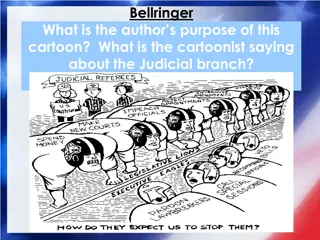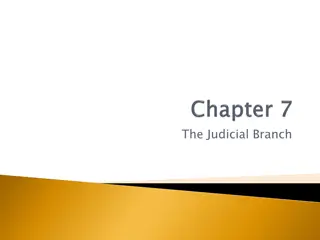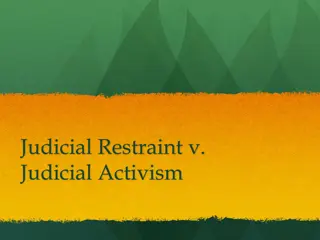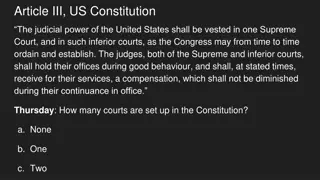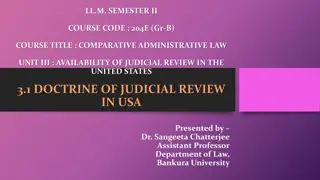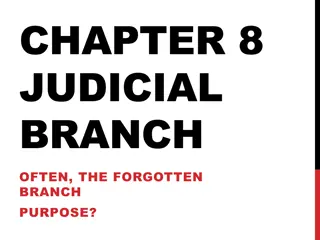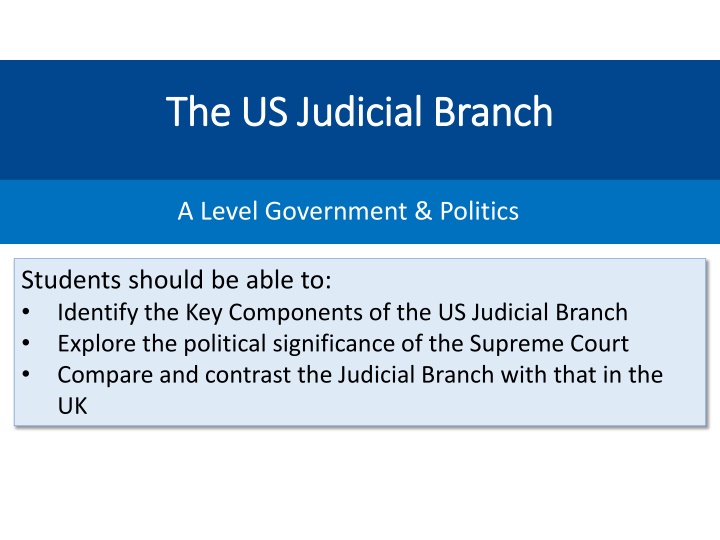
The US Judicial Branch and Its Significance
Explore the US Judicial Branch, its key components, and political importance while comparing it with the UK system. Learn about the structure of the Federal Court System, the Supreme Court's membership, and its role in the Constitution. Discover the membership of the Supreme Court and the ideological balance of its justices.
Download Presentation

Please find below an Image/Link to download the presentation.
The content on the website is provided AS IS for your information and personal use only. It may not be sold, licensed, or shared on other websites without obtaining consent from the author. If you encounter any issues during the download, it is possible that the publisher has removed the file from their server.
You are allowed to download the files provided on this website for personal or commercial use, subject to the condition that they are used lawfully. All files are the property of their respective owners.
The content on the website is provided AS IS for your information and personal use only. It may not be sold, licensed, or shared on other websites without obtaining consent from the author.
E N D
Presentation Transcript
The US Judicial Branch The US Judicial Branch A Level Government & Politics Students should be able to: Identify the Key Components of the US Judicial Branch Explore the political significance of the Supreme Court Compare and contrast the Judicial Branch with that in the UK
The Judicial Branch The Judicial Branch includes: All the US Courts in the Federal Court system from State Courts up to the Supreme Court. The Judicial Branch is a key part of the Separation of Powers
The Judicial Branch and the Constitution The Judicial Branch is set out in the US Constitution in Article III Section 1 sets out the Supreme Court as the only judicial power in the US Congress can ordain and establish new courts Judges shall hold their office for life in good behavior No provision for number of Supreme Court justices No Mention of Judicial Activism
Structure of the Federal Court System The Supreme Court sits at the top of the US Court System United States Supreme Court 1 Court 9 Justices The Supreme Court rejects almost all of the cases brought to it. US Court of Appeals 1 in each of 11 circuits 1 in DC 1 Federal Circuit If this happens, then the ruling of the lower court stands. Only 4% of cases get heard in the Supreme Court US Court of Appeals 1 in each 94 districts
Membership of the Supreme Court The Constitution does not give a set number of justices that must be on the court. The US has tended to have 9 so that a majority can be reached. All have an Ideological Stance 8 Associate Justices 1 Chief Justice FDR did threaten to pack the court Number is set by Congress Job for life in good behaviour
Membership of the Supreme Court (II) Justice Date Appointed Sitting President Ideological Balance Chief Justice John Roberts 2005 George W Bush (R) Right Leaning Associate Justices Position Open XX Donald Trump (R) XX Anthony Kennedy 1988 Ronald Reagan (R) Swing Vote Clarence Thomas 1991 George H W Bush (R) Right Leaning Ruth Bader Ginsburg 1993 William J Clinton (D) Left Leaning Stephen Breyer 1994 William J Clinton (D) Left Leaning Samuel Alito 2005 George W Bush (R) Right Leaning Sonia Sotomayor 2009 Barack H Obama (D) Left Leaning Elena Kagan 2010 Barack H Obama (D) Left Leaning
The Roberts Court Antonin Scalia Anthony Kennedy Clarence Thomas Ruth Bader Ginsburg John Roberts Stephen Breyer Samuel Alito Sonia Sotomayor Elena Kagan
Ideology of the Roberts Court Ruth Bader Ginsburg Antonin Scalia John Roberts Left Right Stephen Breyer Anthony Kennedy Clarence Thomas Sonia Sotomayor Elena Kagan Samuel Alito SWING VOTE
Judicial Philosophy President s often want to appoint Justices that fit their own ideological image Reagan: Obama: Bork, Scalia Sotomayor, Kagan Justices are often seen as conservatives or liberals There are more classifications such as activist.
Judicial Review No constitutional basis for this power Found in Marbury v Madison 1803 Allowed the Court to rule: Acts of Congress Executive Actions State Law UNCONSTITUTIONAL
Comparison to the UK The US Judicial Branch is far more political than the UK due to Presidential appointment. UK US Justices also must retire in the UK there is no requirement for them to do so in the US
The US Judicial Branch The US Judicial Branch A Level Government & Politics Students should be able to: Identify the Key Components of the US Judicial Branch Explore the political significance of the Supreme Court Compare and contrast the Judicial Branch with that in the UK


